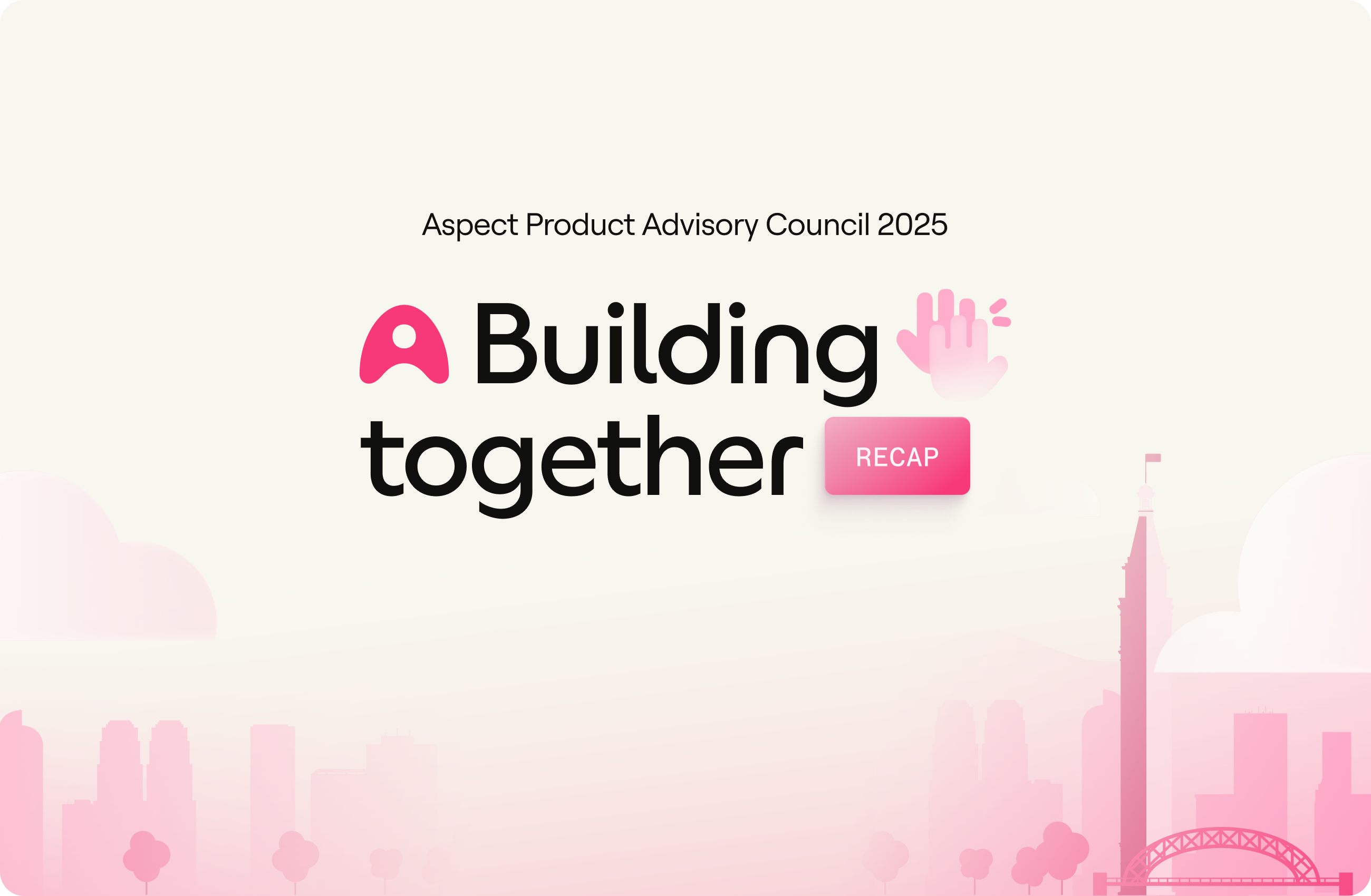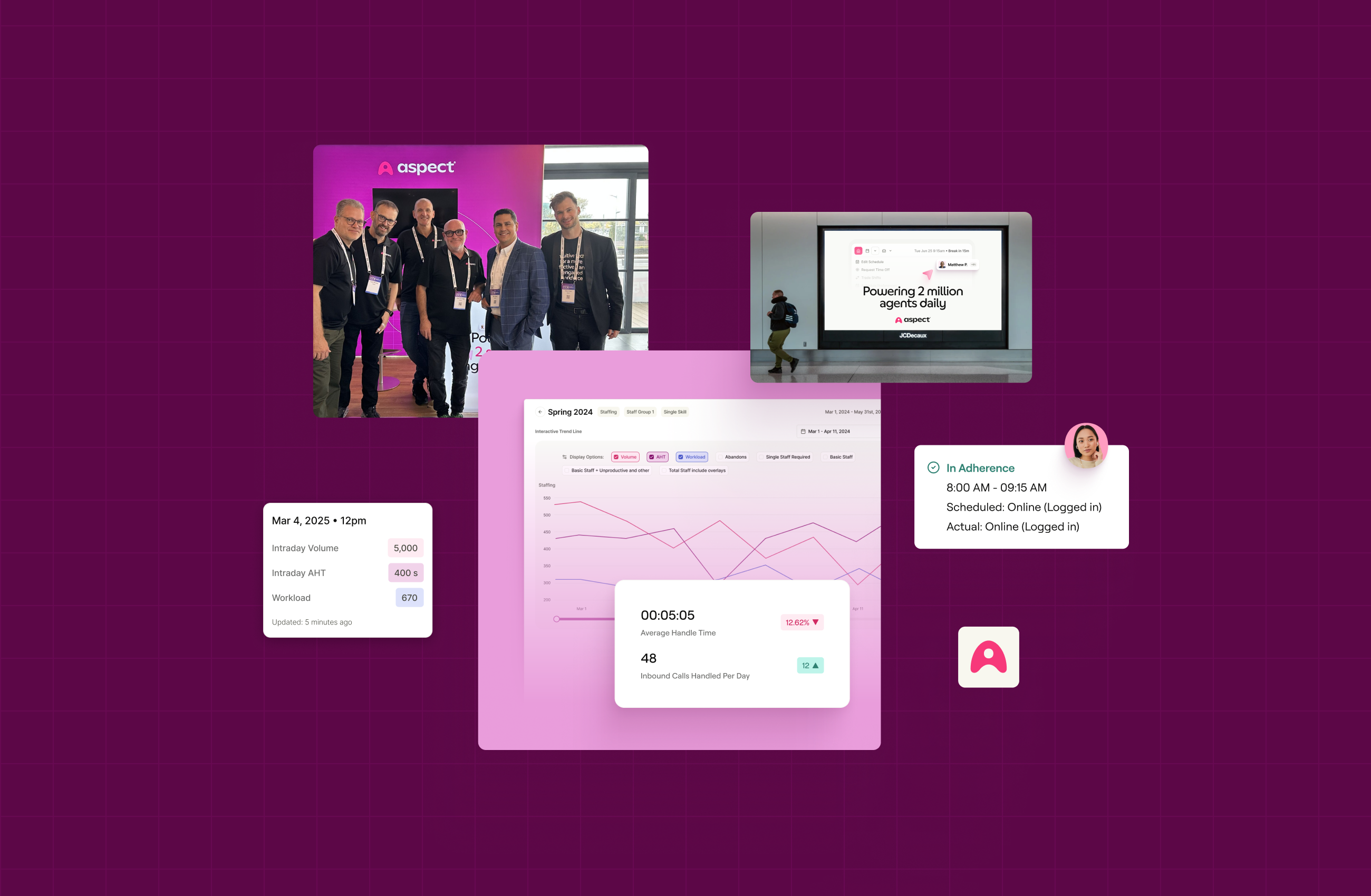It's no secret that AI is transforming workforce management processes, including scheduling.
Between rising service expectations, unpredictable demand, multichannel workloads, and the pressure to provide more flexibility for agents, traditional manual scheduling simply can't keep up. That's why more organizations are turning to AI-powered workforce scheduling to improve forecast accuracy, reduce schedule variance, and help planners build fair, efficient schedules faster.
The push for better efficiency has sped up AI adoption in WFM, including scheduling. According to a McKinsey report, 78% of organizations now use AI for at least one business function—up from 55% in 2023.
In this blog we'll outline some of the key benefits of AI in workforce scheduling and how Aspect's AI philosophy is guiding our development of workforce management software for the future.
“When done right, AI frees up people to do the things only humans can do. It’s about amplifying talent, not replacing it. It’s about giving teams space to breathe, think, and show up as their best selves. And when that happens? That’s when we unlock the next level of performance.” - Darryl Kelly, CEO, Aspect
The landscape of workforce scheduling
Before AI-supported workforce scheduling was introduced, traditional workforce scheduling processes were rooted in manual work, sometimes proving ineffective for large, dynamic workforces.
Inefficient scheduling directly impacts workforce performance. It leads to inadequate staffing levels while causing available employees to become overworked and stressed. This ultimately degrades service and work quality, negatively affecting a business's bottom line and driving managers to seek performance improvements.
Proactive, data-driven workforce scheduling with AI capabilities is a key driver of modern workforce management success.
Learn more: Utilize performance management software to drive workforce success.
How AI scheduling works
How is AI transforming workforce scheduling? Managers exploring AI scheduling solutions will discover powerful technologies that drive automation and boost efficiency through:
- Pattern recognition. Machine learning algorithms identify scheduling trends from historical data that would be missed during manual review, providing more accurate scheduling suggestions.
- Preference & employee inputs. Natural language processing is being implemented to improve scheduling processes, including AI assistants in self-service scheduling and request management workflows.
- Predictive analytics. AI-powered workforce solutions enhance the accuracy of forecasting and staffing through predictive analytics.
- Prioritization & optimization. AI workforce scheduling tools utilize advanced algorithms that balance competing priorities, such as employee preferences and business requirements, to create optimal schedules that satisfy both parties.
Learn more about how Aspect is incorporating AI innovations into our evolving workforce management solutions.
Key benefits of AI-driven workforce scheduling
AI-driven solutions deliver significant benefits for both businesses and employees by filling operational gaps, automating complex processes, increasing scheduling accuracy, and saving valuable time.
Benefits for businesses
Organizations are increasingly discovering compelling business cases for implementing AI solutions. Key benefits include:
- Increased cost savings through optimized staffing. Intelligent workforce scheduling improves workflows, saving time and ultimately, money. According to McKinsey research, the majority of organizations that use Gen AI in most business functions reported cost reductions.
- Improved compliance with labor laws and regulations. Relying on manually tracking compliance can lead to human errors and hefty fines. AI workforce solutions can automate compliance with labor laws and regulations, providing balanced scheduling suggestions.
- Enhanced ability to adapt to dynamic business conditions. Organizations with rapidly changing environments like contact centers require adaptive solutions. AI workforce scheduling tools can respond in real-time to shifting conditions, delivering effective staffing solutions that meet immediate needs.
- Better alignment of staffing with customer demand patterns. AI solutions provide more accurate staffing and customer interaction insights, enabling better-informed business decisions.
Benefits for employees
Tools that utilize generative AI and natural language processing can be especially helpful for improving employee workflows, saving them time and energy to allocate to more complex tasks. Key AI scheduling benefits for employees include:
- Greater schedule flexibility. Improved schedule flexibility directly impacts work-life balance. Employee experience is key to satisfaction, and work-life balance is pivotal in helping people feel seen, heard, and appreciated in the workplace.
- Fair distribution of shifts and overtime opportunities. AI solutions create balanced schedules, eliminating favoritism and distributing shifts and time off based on employee preferences and actual business requirements.
- Reduced scheduling conflicts. More accurate schedules can lead to higher employee satisfaction, as conflicts and schedule changes are minimized.
- Personalized schedules. Not only can AI scheduling solutions account for employee preferences, they can also include factors like employee skills, ensuring the right team member is matched with the shift they're best suited for.
Want to go deeper? Our white paper, Amplifying Human potential with AI, breaks down how AI enhances decision-making, improves employee experience, and strengthens workforce performance. Get the white paper here.
Strategies for implementing AI scheduling in your workforce
Implementing AI workforce scheduling solutions requires a strategic approach to ensure optimal adoption, maximize return on investment, and minimize disruptions to existing workflows.
Some key considerations include:
- Integration capabilities. To avoid interruptions in your business processes, it's important to thoroughly vet integration capabilities with your current technology stack, ensuring your AI scheduling solutions start delivering value as quickly as possible
- Ensuring data quality. Intelligent workforce scheduling is only as smart as the data it's being fed. Organizations must ensure data hygiene and quality for the best application of AI.
- Change management practices. Organizations implementing AI workforce scheduling should develop comprehensive change management strategies that include clearly communicating the benefits of these tools, encouraging adoption, providing continuous training, and gathering user feedback on the implemented solutions.
- Balancing human oversight. AI solutions are meant to save humans time and make jobs easier, not replace them. Workforce scheduling processes still require the human touch and expert oversight.
- Managing security and privacy. Hiring an AI compliance specialist or other AI-related role, especially in large-scale organizations with many business uses for AI, can ensure proper security and privacy management.
Learn more about the ways that AI is changing workforce management and why we need to continue embracing it in the workforce industry.
Future trends in AI workforce solutions
As AI capabilities continue to advance, workforce scheduling will become even more adaptive, precise, and employee-centric. One of the expected shifts is toward real-time, responsive scheduling, where AI learns from incoming demand signals and adjust staffing recommendations to matching what’s happening in the moment.
Another point is the rise of agent-focused scheduling intelligence, where AI helps create personalized shifts based on skills, preferences, and career goals, supporting agent engagement and retention.
Finally, AI will play a larger role in cross-team and cross-channel optimization, bridging forecasting, scheduling, intraday management, and performance insights into a single, connected workflow.
The key is maintaining a balanced, human-centric approach to AI implementation. While some organizations have attempted to replace employees entirely with AI agents, this strategy has often resulted in customer dissatisfaction.
For example, companies like Klarna and Duolingo have had to rehire human staff after over-pivoting to an AI-first approach. These organizations discovered that although AI could perform many agent functions technically, it couldn't replicate the human connection, leading to a significant decline in customer service quality.
Businesses must find a balanced, human-centric approach to implementing AI. One that prioritizes both employees and customers, while additionally improving operations and efficiency. Some businesses like Klarna are opting for balancing AI solutions with gig economy-based work models.
How Aspect helps with AI workforce scheduling
At Aspect, our solutions are evolving to meet the dynamic challenges workforces now face. This includes exploring Workforce Intelligence, the next generation of WEM.
Contact centers now need to forecast and orchestrate a blended workforce of people and channels, each with distinct costs, SLAs, and constraints. Aspect's workforce platform brings these components together so capacity, service levels, and customer experience stay in balance every day.
What this looks like in practice
- Unified demand forecasting: Combine historical data, seasonality, and real-time insights to accurately predict volumes by channel.
- Skills and policy aware: Respect union rules, seniority, shift preferences, and agent skill sets when generating schedules.
- Intraday re-optimization: As reality shifts, Aspect automatically rebalances queues, updates agent assignments, and adjusts thresholds to protect SLAs.
- Closed-loop outcomes: Performance from agents across different channels feeds back into forecasts, improving staffing accuracy over time.
Ready to transform your scheduling strategy? Discover how AI in Aspect Workforce can help you build smarter, more flexible schedules for your contact center.









